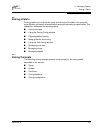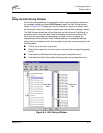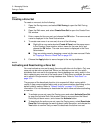
3 – Managing Fabrics
Zoning a Fabric
3-14 59022-03 D
3.4.1.5.1
Auto Save
The Auto Save parameter on a switch determines whether zoning changes
received from other switches in the fabric will be automatically saved to
permanent memory on that switch. Zoning changes you apply to your switch are
automatically saved to permanent memory on your switch, but where those
changes are saved on each switch in the fabric is dependent on whether a switch
has the Auto Save parameter enabled or disabled.
Zoning changes are saved to temporary memory on all switches in the fabric. If
Auto Save is enabled, the switch firmware automatically saves the zoning
changes it receives to both temporary and permanent memory on that switch. If
Auto Save is disabled on a switch, any zoning changes that the switch receives
will be stored only in its temporary memory.
How the save operation is triggered depends on the selected merge mode. When
in SW-2 merge mode, changes are saved when an updated zone set is activated.
When in Brocade™ merge mode, changes are saved when any zone set is
updated. You can save the zoning database to permanent memory (if Auto Save
is disabled) using the Zoning command. Refer to Zoning Command on page A-67.
3.4.1.5.2
Merge Mode
The Merge Mode parameter enables a SANbox2 switch to interoperate with
Brocade switches running non-FC-SW-2-compliant firmware. There are two
merge modes: SW2 and Brocade Proprietary. The SW2 merge mode is intended
for FC-SW-2 compliant switches. The Brocade merge mode is intended for
SANbox2 fabrics that include Brocade switches with non-FC-SW-2 compliant
firmware. All switches in a fabric should be set to the same merge mode,
otherwise the switches may become isolated from each other.
When you activate a zone set, the SW2 merge mode causes the active zone set
to be distributed to temporary memory on all switches in the fabric. This ensures
that all switches have identical active zone sets. The Brocade merge mode
propagates the entire zoning database to temporary memory on all switches in the
fabric anytime the zoning database is changed and saved on any switch.
3.4.1.5.3
Default Visibility
Default Visibility determines the level of communication that is permitted between
devices when there is no active zone set. The default visibility parameter can be
set differently on each switch. When default visibility is enabled (All) on a switch,
the switch and its devices can communicate with all devices in the fabric. When
Default Visibility is disabled (None) on a switch, none of the ports on that switch
can communicate with any other port in the fabric.


















